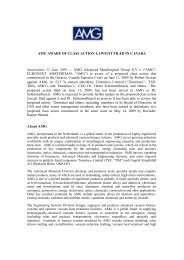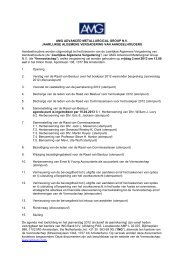C Si Ni Cr V Ti Ta Sc Li Sr Zr Fe Cu Zn Sn B Al Ce U Mn Mo Nb Sb
C Si Ni Cr V Ti Ta Sc Li Sr Zr Fe Cu Zn Sn B Al Ce U Mn Mo Nb Sb
C Si Ni Cr V Ti Ta Sc Li Sr Zr Fe Cu Zn Sn B Al Ce U Mn Mo Nb Sb
You also want an ePaper? Increase the reach of your titles
YUMPU automatically turns print PDFs into web optimized ePapers that Google loves.
Increase/<br />
decrease in<br />
basis points Effect on equity<br />
126 Notes to Consolidated Financial Statements<br />
Effect on profit<br />
before tax<br />
2010<br />
USD +5 112 6<br />
USD -10 (158) (9)<br />
Increase/<br />
decrease in<br />
basis points Effect on equity<br />
Effect on profit<br />
before tax<br />
2009<br />
USD +5 (79) 9<br />
USD -10 (312) (17)<br />
Foreign currency risk<br />
Foreign currency risk is the risk that changes in foreign<br />
exchange rates will affect the Company’s income or the<br />
value of its holdings of financial instruments. Many of<br />
the Company’s subsidiaries are located outside the US.<br />
Individual subsidiaries execute their operating activities in<br />
their respective functional currencies which are primarily<br />
comprised of the US Dollar and Euro. <strong>Si</strong>nce the financial<br />
reporting currency of the Company is US Dollar, the<br />
financial statements of those non US Dollar operating<br />
subsidiaries are translated so that the financial results<br />
can be presented in the Company’s consolidated financial<br />
statements.<br />
Each subsidiary conducting business with third parties<br />
that leads to future cash flows denominated in a currency<br />
other than its functional currency is exposed to the<br />
risk from changes in foreign exchange rates. It is the<br />
Company’s policy to use forward currency contracts to<br />
minimize the currency exposures on net cash flows. For<br />
certain subsidiaries, this includes managing balance<br />
sheet positions in addition to forecast and committed<br />
transactions. For these contracts, maturity dates are<br />
established at the end of each month matching the net<br />
cash flows expected for that month. Another subsidiary<br />
hedges all sales transactions in excess of a certain<br />
threshold. For this subsidiary, the contracts mature at<br />
the anticipated cash requirement date. <strong>Mo</strong>st forward<br />
exchange contracts mature within twelve months and are<br />
predominantly denominated in US Dollars, British Pound<br />
Sterling, Brazilian Reais and Euros. When established,<br />
the forward currency contract must be in the same<br />
currency as the hedged item. It is the Company’s policy<br />
to negotiate the terms of the hedge derivatives to closely<br />
match the terms of the hedged item to maximise hedge<br />
effectiveness. The Company seeks to mitigate this risk<br />
by hedging at least 70% of transactions that occur in a<br />
currency other than the functional currency.<br />
In respect of monetary assets and liabilities denominated<br />
in foreign currencies, the Company ensures that its<br />
net exposure is kept to an acceptable level by buying or<br />
selling foreign currencies at spot rates when necessary to<br />
address short term imbalances.<br />
The Company deems its primary currency exposures<br />
to be in US Dollars and Euros. The following table<br />
demonstrates the sensitivity to a reasonably possible<br />
change in the two functional currencies of the Company:<br />
US Dollar and Euro exchange rates with all other variables<br />
held constant, of the Company’s profit before tax (due<br />
to changes in the fair value of monetary assets and<br />
liabilities) and the Company’s equity (due to changes in<br />
the fair value of forward exchange contracts). Changes in<br />
sensitivity rates reflect various changes in the economy<br />
year-over-year.<br />
Strengthening/<br />
weakening<br />
in functional rate<br />
Effect on<br />
profit<br />
before tax<br />
Effect on<br />
equity<br />
before tax<br />
2010<br />
US Dollar +5% (825) 93<br />
Euro +5% (296) (214)<br />
US Dollar -5% 825 (93)<br />
Euro -5% 296 214<br />
Strengthening/<br />
weakening<br />
in functional rate<br />
Effect on<br />
profit<br />
before tax<br />
Effect on<br />
equity<br />
before tax<br />
2009<br />
US Dollar +5% (227) 515<br />
Euro +5% (182) (80)<br />
US Dollar -5% 227 (515)<br />
Euro -5% 182 80<br />
Commodity price risk<br />
Commodity price risk is the risk that certain raw<br />
materials prices will increase and negatively impact the<br />
gross margins and operating results of the Company.<br />
The Company is exposed to volatility in the prices of<br />
raw materials used in some products and uses forward<br />
contracts to manage these exposures. For certain metals,<br />
the Company aims to maintain a greater than 50% hedged<br />
position in order to avoid undue volatility in the sales<br />
prices and purchase costs attained in the normal course<br />
of business. Commodity forward contracts are generally<br />
settled within twelve months of the reporting date.<br />
Changes in sensitivity rates reflect various changes in the<br />
economy year-over-year.







